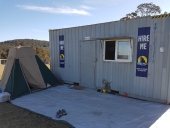Anne Miller wrote:
What the heck is thermal bridging?
Thermal bridging is the issue you get where something solid (or just more conductive), like a bolt, or the framing in a traditional framed wall, passes through your insulation. An an example, you have a wall insulated with 6 inches of insulation between your studs. 6 inches of insulation gets you right around R-20. Problem is, the studs have the insulation value of wood, which in pine is about 1.3 per inch. So your R-20 wall isn't nearly R-20 anymore. It's R-20 mixed with less than R-8 at every stud. There are ways to mitigate the issue, but they complicate building and so are rarely done. A bolt would be far, far worse than wood. A carbon steel bolt 6 inches long has an R-rating of .018, so for all intents and purposes, 0.








